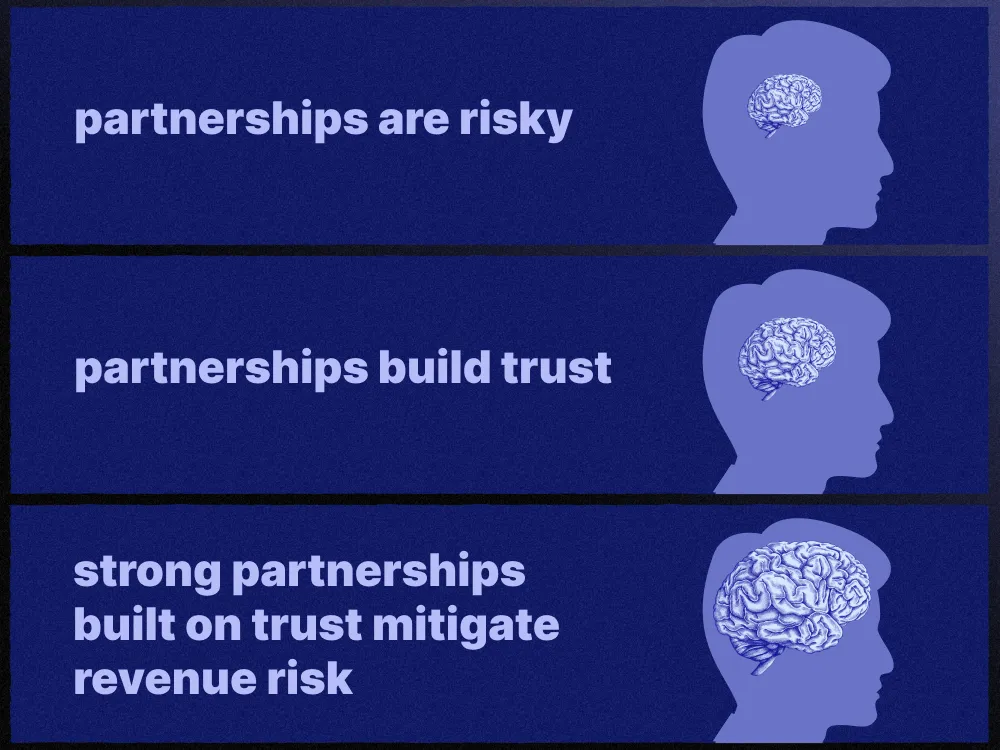Scaling your business with partners is a satisfying and rewarding process. However, navigating the risks of external collaboration while learning to trust potential partners can be unnerving.
PartnerStack’s Your GTM Fortune provides an interactive reading for partner leaders to learn more about your possible future with partners and gain a competitive advantage. In the meantime, here are some strategies to overcome your fears and mitigate risks.
Understanding the risks in partnerships
Before committing to partnerships, you must understand the business risks you may face. Knowing the potential implications of an external collaboration means you can mitigate or avoid negative consequences ahead of time, thus minimizing your overall risk while building trust. Here are some examples of the risks you may face.
Differing goals and expectations
If you and your partners aren’t on the same page, you might not see the growth or results you expected. Furthermore, when aligned parties don’t have similar long-term goals, it can create hostility or an unfavorable experience as the external collaboration continues.
Related: How partnership OKRs create alignment, transparency and revenue impact.
Lack of support
Partnership managers play a crucial role in the development, continuation and ability to grow throughout a partnership’s life cycle. Without a dedicated partner manager, your program may not receive the attention it needs to thrive. As a revenue leader, ensure that partnerships have the resources needed to grow.
Loss of control
When you bring on external partners, you’re trusting them to hold up their end of the partnership, which can be scary. Investing in automated processes or AI tools that eliminate the need for manual support can help, allowing you both to focus on strategy and growth.
No return on investment
The thought of paying too much for unreliable leads may keep you up at night, so knowing where the money is going is essential. Track data, analyze ROI and agree on a timeline with your partners. Partnerships are an investment that requires time to grow and evolve.
A changing market
Navigating new and evolving markets can be chaotic, and the changing landscape isn’t always in your control. However, working with external partners on creative ways to ride those changes and make them work in your favor can be a superpower, especially if you focus on the things that are in your control.
Your brand’s reputation
You’ve worked hard to build your business reputation and you may worry about how external collaboration could impact that in the case of a negative experience. That’s why recruiting the right partners and doing due diligence is critical, as is a clear exit strategy if things go south.

See more: Win internal trust and buy-in for your partner program.
The importance of trust in partnerships
Trust is a cornerstone of successful partnerships because it allows you to work together to reach common goals. Trust is crucial in fostering an environment where you can take (and mitigate!) risks to pursue innovation, reduce conflicts, increase productivity and collaboration, promote effective communication and scale your business in a meaningful and fulfilling way.
Best practices for managing partnerships
A dedicated headcount to manage partnerships is essential for building trust and navigating risk. It’s crucial to create an environment of transparency and open communication that allows you to stay on the same page as partners.
Set clear expectations and goals for the partnership and work towards those common objectives to ensure both sides are satisfied with the collaboration. Follow through with commitments and promises, be dependable and show your partner they can rely on you.
Always acknowledge and celebrate your partner’s contributions to create mutual respect.
It’s equally important to provide regular updates and check-ins to see if the partnership is on track. Make sure you’re operating within the agreed-upon terms and offering value to strengthen that partnership as it continues.
Strategies for building trust
There are multiple ways to establish and build trust in a successful partnership as you scale your business and expand your ecosystem. Trust is earned (just peek The Severed Handshake card), so start internally and pay attention to the details. Here are some specific strategies that help build trust and minimize risk.

Drive innovation through collaboration
External partners can help drive innovation and provide a competitive advantage in several ways. So, building trust and fostering open communication with them is essential. Partners open the door to new technologies and expertise, providing access to innovations that would be time-consuming and costly to develop on your own.
Partnerships diversify your ability to generate ideas, solve problems and allow you to share resources to accelerate innovation. Doing so also mitigates risks while expanding your market reach and it creates an environment of learning and feedback that can further scale both your businesses.
See it in action: How Genesys fuels partnership growth at scale with operating efficiencies supported by PartnerStack.
Understand legal risks
Knowing and managing legal risks associated with external partnerships is essential in any successful program. Common legal risks include contractual disputes, IP issues and ownership, confidentiality and security. Mitigate those risks by paying attention to the details.
Comprehensive and transparent contracts are a good start. Ensure you have IP clauses that define ownership and usage rights, use NDAs where necessary and provide training to employees and partners for optimal security.
Ensure compliance with regulations
Security and privacy regulations in partnerships can be tricky to navigate, so it’s important to safeguard yourself with compliance programs and regular audits. Doing so also protects sensitive information and fosters trust between partners and customers. Implementing these programs and ensuring you comply with regulations will minimize your financial and reputational risks.
You might also like: How to do privacy in partnerships right (and why it matters).
Explore new markets
Gain a competitive advantage by diversifying your partnerships to explore new markets and opportunities. You can differentiate yourself from others by offering unique services while mitigating overall risk and tapping into new revenue streams and opportunities.
Diverse partnerships foster new perspectives and ideas, expose you to various markets that may help protect your business when one takes a downturn and give you access to local partners that can help navigate tricky regulatory landscapes.
Engage with different types of partners and programs
No one wants to put all their eggs in one basket, so creating a diverse ecosystem of partners is essential to your overall partnership strategy. Diversifying your partners — and your program offerings — is an excellent way to navigate potential risks.
Consider partners that offer different advantages across all sectors, including academic institutions, government agencies and private companies. While private partners can help with resource sharing and market expansion, government agencies offer regulatory insights, policy influence, and potential funding or incentives. Academic institutions provide access to expertise and new talent, top development and innovation opportunities, and the possibility of joint research projects and grants.
Scaling your business with external partners can take a leap of faith but is ultimately extremely rewarding. Navigate risks in your partnerships through research, analysis and diversification. Pay attention to the details, and cover your bases with solid contracts and compliance programs.
Remember that trust is earned, so start at home. Foster open communication and implement strategies that build trust over time. Be dependable, follow through with commitments, and create mutual respect. In doing so, you’ll not only overcome your fears but you’ll put yourself on the path to long-term success.
This article was originally published in August 2024.

















